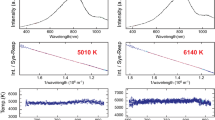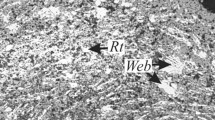Abstract
The behavior of the ammoniated feldspar buddingtonite, NH4AlSi3O8, has been studied using infrared (IR) spectroscopy up to ~30 GPa and using synchrotron powder X-ray diffraction to 10 GPa at room temperature. We examine the bonding of the ammonium ion under pressure and in particular whether hydrogen bonding is enhanced by compaction, as well as probe how the ammonium ion affects the elasticity and behavior of the aluminosilicate framework at pressure. Powder diffraction data yield a bulk modulus of 49 GPa for a pressure derivative of 4, implying that the ammonium ion substitution may induce a modest softening of the feldspar lattice relative to the potassium ion. Under compression, the N–H vibrations are remarkably insensitive to pressure throughout the pressure range of these experiments. However, the vibrations of the aluminosilicate framework of buddingtonite undergo changes in their slope at ~13 GPa, implying that a change in compressional mechanism occurs near this pressure, but the vibrational modes of the ammonium molecule show little response to this change. These results show that (1) there is little, if any, enhancement of hydrogen bonding between the ammonium ion and the oxygen ions of the silica and aluminum tetrahedral framework under pressure, as manifested by the slight (and mostly positive) shifts in the N–H stretching vibrations of the ammonium ion; (2) ordering of the ammonium ion is not observed under compression, as no changes in peak width or in the general appearance of the spectra are observed under compression; and (3) structural changes induced by pressure in the aluminosilicate framework do not produce significant changes in the bonding of the ammonium ion. Hence, it appears that the ammonium ion interacts minimally with its surrounding lattice, even at high pressures: Its behavior is compatible with it being, aside from Coulombic attraction to the oxygen-dominated matrix, a largely non-interactive guest molecule within the silicate framework. This lack of interaction with the surrounding oxide lattice under compression may impact the stability of ammoniated minerals at high pressures and temperatures and ultimately likely favors nitrides or fluid phases as the dominant nitrogen carriers within the deeper mantle.







Similar content being viewed by others
References
Angel RJ (2004) Equations of state of plagioclase feldspars. Contrib Mineral Petrol 146:506–512
Angel RJ, Hazen RM, McCormick TC, Prewitt CT, Smyth JR (1988) Comparative compressibility of end-member feldspars. Phys Chem Miner 15:313–318
Angel RJ, Gonzales-Platas J, Alvaro M (2014) EosFit-7c and a Fortran module (library) for equation of state calculations. Z Kristallogr 229:405–419
Atkinson AJ, Carpenter MA, Salje EKH (1999) Hard mode infrared spectroscopy of plagioclase feldspars. Eur J Miner 11:7–21
Barker DS (1964) Ammonium in alkali feldspars. Am Miner 49:851–858
Bebout GE, Lazzeri KE, Geiger CA (2016) Pathways for nitrogen cycling in Earth’s crust and upper mantle: a review and new results for microporous beryl and cordierite. Am Mineral 101:7–24
Bjerrum NJ (1914) Theorie der alkalimetrischen und azidimetrischen titrierungen. Verlag Ferdinand Enke, Stuttgart
Busigny V, Cartigny P, Philippot P, Ader M, Javoy M (2003) Massive recycling of nitrogen and other fluid-mobile elements (K, Rb, Cs, H) in a cold slab environment: Evidence from HP to UHP oceanic metasediments of Schistes Lustres nappe (western Alps, Europe). Earth Planet Sci Lett 215:27–42
Couty R, Velde B (1986) Pressure-induced band splitting in infrared spectra of sanidine and albite. Am Mineral 71:99–104
Dauphas N, Marty B (1999) Heavy nitrogen in carbonatites of the Kola Peninsula: a possible signature of the deep mantle. Science 286:2488–2490
Dobrzhinetskaya LF, Wirth R, Yang J, Hutcheon ID, Weber PK, Green HW II (2009) High-pressure highly reduced nitrides and oxides from chromitite of a Tibetan ophiolite. Proc Natl Acad Sci 106:19233–19238
Downs RT, Hazen RM, Finger LW (1994) The high-pressure crystal chemistry of low albite and the origin of the pressure dependency of Al–Si ordering. Am Mineral 79:1042–1052
Halama R, Bebout GE, John T, Scambelluri M (2014) Nitrogen recycling in subducted mantle rocks and implications for the global nitrogen cycle. Int J Earth Sci 103:2081–2099
Hamann SD (1978) Influence of pressure on infrared-spectra of hydrogen-bonded solids. VI. Ammonium salts. Aust J Chem 31:11–18
Harlov DE, Andrut M, Pöter B (2001) Characterisation of buddingtonite (NH4)[AlSi3O8] and ND4-buddingtonite (ND4)[AlSi3O8] using IR spectroscopy and Rietveld refinement of XRD spectra. Phys Chem Miner 28:188–198
Haussühl S (1993) Thermoelastic properties of beryl, topaz, diaspore, sanidine and periclase. Z Kristallogr 204:67–76
Herzberg G (1945) Infrared and Raman spectra of polyatomic molecules. Van Nostrand, New York
Hill R (1952) The elastic behavior of a crystalline aggregate. Proc Phys Soc Sect A 65:349–354
Holland TJB, Redfern SAT (1997) Unit cell refinement from powder diffraction data: the use of regression diagnostics. Mineral Mag 61:65–77
Honma H, Itihara Y (1981) Distribution of ammonium in minerals of metamorphic and granitic rocks. Geochim Cosmochim Acta 45:983–988
Hovis GL, Morabito JR, Spooner A, Mott A, Person EL, Henderson CMB, Roux J, Harlov D (2008) A simple predictive model for the thermal expansion of AlSi3 feldspars. Am Mineral 93:1568–1573
Jeon S, Porter RF, Ruoff AL (1988) High-pressure Raman study of ammonium halides. J Raman Spectrosc 19:179–182
Li Y, Keppler H (2014) Nitrogen speciation in mantle and crustal fluids. Geochim Cosmochim Acta 129:13–32
Li Y, Wiedenbeck M, Shcheka S, Keppler H (2013) Nitrogen solubility in upper mantle minerals. Earth Planet Sci Lett 377–378:311–323
Loughnan FC, Roberts FI, Lindner AW (1983) Buddingtonite (NH4-feldspar) in the Condor Oilshale Deposit, Queensland, Australia. Mineral Mag 47:327–334
Mao HK, Xu J, Bell PM (1986) Calibration of the ruby pressure gauge to 800 kbar under quasi-hydrostatic conditions. J Geophys Res 91:4673–4676
Marty B, Dauphas N (2003) The nitrogen record of crust–mantle interaction and mantle convection from archean to present. Earth Planet Sci Lett 206:397–410
Merrill L, Bassett WA (1974) Miniature diamond anvil pressure cell for single crystal X-ray diffraction studies. Rev Sci Instrum 45:290–294
Mikhail S, Sverjensky D (2014) Nitrogen speciation in upper mantle fluids and the origin of Earth’s nitrogen-rich atmosphere. Nat Geosci 7:816–819
Mingram B, Brauer K (2001) Ammonium concentration and nitrogen isotope composition in metasedimentary rocks from different tectonometamorphic units of the European Variscan Belt. Geochim Cosmochim Acta 65:273–287
Mookherjee M, Redfern SAT, Swainson I, Harlov D (2004) Low temperature behavior of ammonium ion in buddingtonite [NH4AlSi3Oß] from neutron powder diffraction. Phys Chem Miner 31:643–649
Mookherjee M, Welch MD, Le Pollès L, Redfern SAT, Harlov DE (2005) Ammonium ion behaviour in feldspar: variable-temperature infrared and 2HNMR studies of synthetic buddingtonite, N(D, H)4AlSi3O8. Phys Chem Miner 32:126–131
Palya AP, Buick IS, Bebout GE (2011) Storage and mobility of nitrogen in the continental crust: evidence from partially melted metasedimentary rocks, Mt. Stafford. Aust Chem Geol 281:211–226
Pampeyan EG (2010) Buddingtonite in Menlo Park, California. USGS Open-File Report 2010-1053, pp 1–10
Paterson MS (1982) The determination of hydroxyl by infrared-absorption in quartz, silicate-glasses and similar materials. Bulletin de Mineralogie 105:20–29
Pöter B, Gottschalk M, Heinrich W (2007) Crystal-chemistry of synthetic K-feldspar-buddingtonite and muscovite-tobelite solid solutions. Am Mineral 92:151–165
Prescher C, Prakapenka VB (2015) DIOPTAS: a program for reduction of two-dimensional X-ray diffraction data and data exploration. High Press Res 35:223–230
Reed JW, Williams Q (2006) An infrared spectroscopic study of NH4Br—ammonium bromide to 55 GPa. Solid State Commun 140:202–207
Rietveld HM (1969) A profile refinement method for nuclear and magnetic structures. J Appl Crystallogr 2:65–71
Sano Y, Takahata N, Nishio Y, Fischer TP, Williams SN (2001) Volcanic flux of nitrogen from the Earth. Chem Geol 171:263–271
Schmidt C, Watenphul A (2010) Ammonium in aqueous fluids to 600 C, 1.3 GPa: a spectroscopic study on the effects on fluid properties, silica solubility and K-feldspar to muscovite reactions. Geochim Cosmochim Acta 74:6821–6866
Shannon RD (1976) Revised effective ionic radii and systematic studies of interatomic distances in halides and chalcogenides. Acta Crystallogr Sect A 32(5):751–767
Thompson EC, Campbell AJ, Liu Z (2016) In-situ infrared spectroscopic studies of hydroxyl in amphiboles at high pressure. Am Mineral 101:706–712
Toby BH (2001) EXPGUI, a graphical user interface for GSAS. J Appl Crystallogr 34:210–213
Voncken JHL, van Roermund HLM, van der Eerden AMJ, Jansen JBH, Erd RC (1993) Holotype buddingtonite: an ammonium feldspar without zeolitic H2O. Am Mineral 78:204–209
Waeselmann W, Brown JM, Angel RJ, Ross N, Zhao J, Kaminsky W (2016) The elastic tensor of monoclinic alkali feldspars. Am Mineral 101:1228–1231
Wagner EL, Hornig DF (1950) The vibrational spectra of molecules and complex ions in crystals IV. Ammonium bromide and deuteron-ammonium bromide. J Chem Phys 18:305–312
Watenphul A, Wunder B, Heinrich W (2009) High-pressure ammonium-bearing silicates: hydrogen storage in the Earth’s mantle. Am Mineral 94:283–292
Watenphul A, Wunder B, Wirth R, Heinrich W (2010) Ammonium-bearing clinopyroxene: a potential nitrogen reservoir in the Earth’s mantle. Chem Geol 270:240–248
Williams Q (1998) High-pressure infrared spectra of feldspars: constraints on compressional behavior, amorphization, and diaplectic glass formation. In: Manghnani MH, Yagi T (eds) Properties of Earth and planetary materials at high pressures and temperatures. Wiley, Washington DC, pp 531–543
Williams Q, Jeanloz R (1988) Spectroscopic evidence for pressure-induced coordination changes in silicate glasses and melts. Science 239:902–905
Zhang Y, Zindler A (1993) Distribution and evolution of carbon and nitrogen in earth. Earth Planet Sci Lett 117:331–345
Acknowledgments
This work was supported by the US NSF via EAR-1215745 and -1620423 and COMPRES under NSF Cooperative Agreement EAR 11-57758. The Advanced Light Source is supported by the Director, Office of Science, Office of Basic Energy Sciences of the US Department of Energy under Contract No. DE_AC02-05CH11231. We thank Dale Burns of Stanford University for assistance with the electron microprobe analysis. We are also grateful to C.M. Beavers for experimental advice and two anonymous reviewers for helpful comments.
Author information
Authors and Affiliations
Corresponding author
Rights and permissions
About this article
Cite this article
E. Vennari, C., O’Bannon, E.F. & Williams, Q. The ammonium ion in a silicate under compression: infrared spectroscopy and powder X-ray diffraction of NH4AlSi3O8—buddingtonite to 30 GPa. Phys Chem Minerals 44, 149–161 (2017). https://doi.org/10.1007/s00269-016-0844-3
Received:
Accepted:
Published:
Issue Date:
DOI: https://doi.org/10.1007/s00269-016-0844-3




